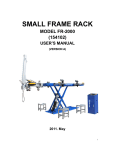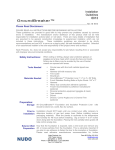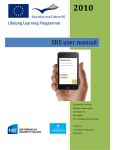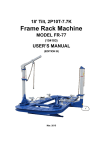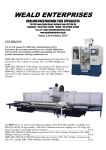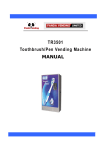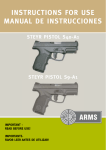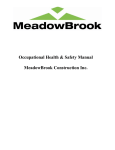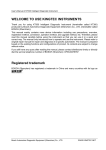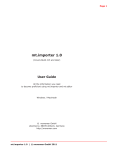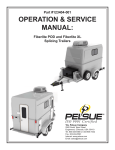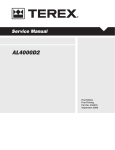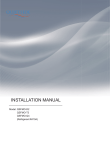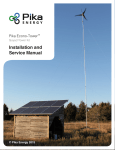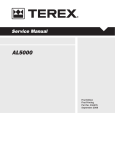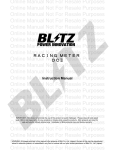Download SCISSOR FRAME RACK MACHINE
Transcript
SCISSOR FRAME RACK MACHINE MODEL FR-55 (154102) USER’S MANUAL (EDITION A) 2015 Mar. Content Preface Chapter 1:Safety caution Chapter 2:Introduction of the machine (specification and usage) Chapter 3:Delivery and receiving Chapter 4:Lifting system 4.1 Safety 4.1.1 4.1.2 4.1.3 4.2 Lifting frame structure 4.2.1 4.2.2 4.2.3 4.3 Bench Lifting device Hydraulic system Installation and test 4.3.1 4.3.2 4.3.3 4.3.4 4.4 General introduction Warning and important notes Safety device General introduction Location requirements Installation of lifting bench Fix to the ground and test Operation 4.4.1 4.4.2 4.4.3 General introduction Vehicles lifting operation and warnings Vehicles loading operation and warnings 4.5 Maintenance 4.6 Disassembly and repairing 4.6.1 4.6.2 4.6.3 General introduction Mechanical parts More 2 Chapter 5: Tower system 5.1 Safety 5.1.1 5.1.2 5.2 General introduction Warnings Drawing arm 5.2.1 5.2.2 5.3 Structure Specification Installation and test 5.3.1 5.3.2 5.3.3 5.4 Matching How to fix on to platform How to disassemble from platform Operation 5.4.1 5.4.3 5.5 Preparation before pulling Some examples Maintenance 5.5.1 5.5.2 5.5.3 5.5.4 Chapter 6: General introduction Hydraulic system Mechanical parts Disassembly of accessories Clamping 6.1 General introduction 6.2 Basement of clamp 6.3 Jaw 6.4 Work principle Chapter 7: Trouble shooting Ending 3 PREFACE As the increasing development in auto technology and extensive using of new materials, the repairing technique has to meet the needs of auto industry’s development. The traditional auto’s body is made from soft steel or medium steel but the modern auto body is made from hard steel, which leads to great differences in repairing. After collision, we have to apply full range cold pulling to straighten and avoid heating repairing in case of any change in metal’s inner structure which will reduce the intensity. Model FR-55 applies hydraulic power and provides many plate metal accessories which can help us to recover the collided places to the original state. In order to guarantee the precision of straightening, A set of high-precision measuring system is needed. This manual includes installation, using as well as maintenance. It has very specific introduction on machine’s structure principle, basic using and flexible using of accessories. During installation, using and operation, please obey the safety requirements of this manual strictly in order to avoid any emergency and injury. We have very detailed prescripts over the max load and max pressure, please obey it strictly in case of any danger and damage to property and injury to people. Model FR-55has full consideration over the practical repairing, and it has safety design on structure, dimension and choice in materials. Based on pragmatism and humanism, our bench is designed and collocated in order to help the repairing workers more. 4 CHAPTER 1 Safety SAFETY CAUTION is of greatest importance. The workers should use the products strictly according to our instruction carefully. 1. Before repairing the damaged vehicle, the workers must, refer to the service manual, do as what the book says. 2. Before repairing, the workers must measure and analyze the damaged vehicle, then make adjustment process planning, and do according to it. 3. Before repairing the damaged vehicle, use the handbrake to avoid the movement of the vehicle. 4. When the platform is lifted or descended, pay attention to the tools, hydraulic tubes and air tubes, etc. it is forbidden to bake the hydraulic pump by fire. 5. Check the seal of hydraulic system often. 6. The workers who are not trained are forbidden strictly to operate the product. 7. Before pulling, the damaged vehicle must be clamped tightly. During the pulling, the vehicle is forbidden to move. 8. The pulling tools must be clamped tightly on the damaged parts, make sure that the pulling tools cannot come off during pulling. 9. During the pulling, it is forbidden to use jack to anchor the damaged vehicle, and the workers are forbidden to stand under the vehicle. 10. During the pulling, the pressure gauge of the hydraulic pump should not surpass 6000PSI. 11. The workers are forbidden to stand beside the vehicle when the vehicle is lifting. Some workers should help the driver to control the direction beside the platform when the vehicle is loading. The workers are forbidden to stand behind the stressed chain or pulling tools. 12. Before using the chain, check whether there are any bend, twist, knot, damaged parts, if there are, change the chain at once. 13. The chain is forbidden to use bolt or bend to make it longer or shorter, if necessary, use the special tool (e.g. DC-G4120). It is forbidden to bake the chain by fire. 5 CHAPTER 2 INTRODUCTION Model FR-55 is a frame style collision repair system. It features low starting point, high lifting height, smooth lifting and lowering, strong hydraulic power, universal and standard fixing system as well as various tools. There is no dead point in the pulling tower’s working scope which makes sure straightening in multi-point and all-wave. Our measuring system can be used to measure both the chassis and auto body. Comparing with the vehicle’s data sheet to judge if it accords with the original data, thus we can make sure of the precision of repairing in this scientific way. Model FR-55 SPECIFICATIONS Bench length---------------123-5/8” (3140mm) Bench width ----------------37” (940mm) Bench height---------------4-3/4”—63” (120-1600mm) Hydraulic pressure--------6000PSI (Max) Post Max. Tension -----------100KN Post Working Rang ----------360° Pneumatic Pressure ---------0.5-0.8Mpa Total weight------------------3500lbs (1600Kg) Max load----------------------5500lbs (2500Kg) Noises-------------------------≤75dB 6 CHAPTER 3 TRANSPORTATION AND RECEIVING 1、Transportation The transporting truck must be longer and wider than the bench itself. During transporting, the machine should be fixed in order to avoid bumping. Every single part of the machine and the painting will not be damaged. Moreover the machine must be protected from rain. 2、Hoisting and installation Use hoisting machine with 11000lbs (5 ton) capacity to hoist the bench. Use four steel ropes symmetrically on the four positions of the bench to avoid tilt. If using a forklift, the fork length must be 1 meter long and the lifting capacity should be more than 4400lbs (2ton). The two arms should be used to lift the bench transversely. The weight on the two side of the arm shall be even in order to avoid tilt. 3、Receiving introduction Please check the goods if the machine and accessories are in accordance with what you ordered and there is no damage in transportation. If there is any unconformity in quantity or damage, please contact with your distributor immediately. 7 CHAPTER 4 PLATFORM MANUAL 4.1 Safety 4.1.1 General Information given in this manual describes the suggested best working practices and should in no way take precedence over individual responsibilities or local regulations. Great effort has been placed on the design and manufacture of the model 154120 lifting platform so that it will comply with all applicable safety aspects for this type of equipment. During operation and other work, it is always each individual’s responsibility to consider the following things: z z Their own and others’ personal safety. Make sure of the safety of the lifting platform through correct use of the equipment in accordance with the descriptions and instructions given in this manual. By observing and following the safety precautions, the user of the TECHER 2 lifting platform will ensure safe working conditions for himself / herself and his/her fellow workers. To avoid personal injury, the following regulations must be observed: z Maximum vehicle weight = 5,500lbs (2,500Kg.) z Check to make sure that the lift is fixed securely to the floor in accordance with the installation instruction, refer to Chapter 3.6. z Check to make sure that there are no objects obstructing the movement of the lift. z Check to make sure that the vehicle is positioned correctly on the lift and that it cannot move during a lift. z Always keep a careful watch on the lift and its load when raising and lowering. Keep lift area clear. z Ensure that nobody is close to the lift when it is operating. z Read the manual carefully for information regarding installation, operation, maintenance and trouble shooting. Various warnings and notices are placed beside illustrations and important descriptive texts in this manual. These warnings and notices are important to ensure the safety of the user and others. Safety signs must also be in place on the equipment. These are intended to warn of hazardous situations or to draw attention to incorrect uses of the equipment. 8 4.1.2 Warnings and important notices Prohibited! Prohibit behavior that may cause injury. Warning! Warnings of personal injuries or of damages in equipment. The following warnings and important notices are used in the instruction manual: WARNING! (In bold, italic type) is used in this manual to indicate a possible danger that could lead to personal injury. An instruction is normally given, followed by a short explanation plus the possible effect if the instruction is not followed. IMPORTANT! (In bold, italic type) is used in this manual to indicate practical information. It is also used to indicate a possible danger that could damage to the equipment and/or cause environmental damage. NOTE! (In bold, italic type) is used to emphasize supplementary information that is required for problem-free use of optimal use of the lifting platform. In addition to the safety signs illustrated above, the following warnings and important notices appear in the manual: WARNING! Make sure that the four main clamps grip the vehicle firmly during lifting. Otherwise the vehicle might overturn and injure people around. WARNING! ! Maximum allowed vehicle weight is 5,500lbs (2,500 kg). Be careful and try to prevent platform tilting, which may cause injuries. ! WARNING! The lifting platform is heavy. Use only approved lifting equipment to avoid accidents. Risk of injuries. ! ! ! WARNING! Danger of tripping on loose hoses. Risk for injuries. WARNING! Before lowering the platform, make sure that the immediate area is cleared. Risk for crush injuries. 9 WARNING! The FR-55 lifting platform is designed to be permanently anchored to the floor. If the lift is used without being properly anchored to the floor according to these instructions, there is an imminent risk that it will tilt and causes injuries. WARNING! If there is any uncertainty regarding the quality of the floor, please get an expert to inspect the floor before the lifting platform is anchored to the floor. Risk of platform tilting may cause injuries. WARNING! When tightening the anchor bolts, the torque wrench value [53 Nm (469lbf.in)] must be reached. If the anchoring is unsatisfactory, the lifting platform might overturn during a lift and cause injuries. WARNING! ! Always be extremely careful when working with jacks or hydraulic equipments. Risk of falling or of flying objects. ! WARNING! It is not allowed to place more than one extension block (Extension 60) on each lifting pad. Risk of vehicle tilting. ! ! ! ! ! WARNING! When placing the vehicle on the lifting platform, make sure that the vehicle is placed within the maximum deviation. Otherwise the vehicle might overturn and injure someone. WARNING! When the lift is in use, the entire vehicle should be supported by the lifting platform. Do not lift one end of the vehicle while the other end is resting on the floor. Risk of vehicle overturning may cause injuries. ! WARNING! Before raising or lowering the lift, ensure that no one is near the lifting platform. Risk of crushing injuries. ! WARNING! Do not stand above the lift or under it when it is operating. Risk of injuries. ! ! WARNING! During all service and maintenance work with the lift in raised position, the bench must be blocked against unintentional lowering. Risk of crushing injuries. WARNING! Be careful during transportation. 10 ! IMPORTANT! It is the responsibility of the owner to ensure that the equipment has been installed as specified in the instructions provided. It is also the owner’s responsibility to ensure that the lift is inspected in accordance with current and local regulations before it is used. ! IMPORTANT! The lifting platform should not be used for anything other than vehicle repairs. ! IMPORTANT! Mae sure there are no objects obstructing the movement of the lift. ! IMPORTANT! Always keep a careful watch on the lift and its load when raising and lowering. ! IMPORTANT! Observe high standards of cleanliness when working with the hydraulic equipment. Dirt in the hydraulic oil can result in breakdowns and subsequent loss of revenue. ! IMPROTANT! For the sake of the environment, dismantle the equipment in a environmentally friendly way. WARNING! ! ! Before raising or lowering the lift, ensure that no one is near the lifting platform. Risk for crushing injuries. WARNING! Do not perform any alignment work when the vehicle is supported by the lifting pads only. Otherwise, the draw aligner might overturn the vehicle and thereby cause serious injuries. 4.1.3 Use of safety device Operators’ safety is fully considered in anti-fall system designing of platform. The following is the manual and notices of it. 1)Designing principle: When the bench lifts up, the anti-drop board will drop into the slot of height limitation automatically. This will avoid the sudden drop of the bench. 2)Safety system operating during lifting: Before lifting, please make sure that the red button on the top of the hydraulic controller is in ejected state. When you lift the bench to desired height, please make sure that anti-drop board is in the slot of height limitation board. If not, please adjust the lifting height of bench till the anti-drop board is in the slot, then you can start to operate. 11 3)Operating of safety system during lowering: After the repairing is finished, please lift the bench slowly till the anti-drop board leaves height limitation board, and then press the red button of the hydraulic controller. The compressed air will lift the air cylinder and then depressurize the oil cylinder, in this way, bench will drop slowly. When the bench drops to the lowest position, depressurize the air tank, rotate the red button counter-clockwise and the red button will bounce automatically, the cooperation is over. Forbidding: Before that the anti-drop board is in the slot of height limitation, it is forbidden to stretch any part of body under the bench or to start repairing. 4.2 Lifting system 4.2.1 Bench Model FR-55 has a working platform where accidental vehicles are loaded. When the lifting bench is on its lowest position, it is only 120mm above the ground, which guarantees the convenience to drive on vehicles. The working platform is lifted by hydraulic lifting device. During lifting a vehicle, the vehicle is supported by the rub mats which are installed on the basement of main clamps. Warning! During lifting, we must make sure that the vehicle is supported by the four rub mats otherwise vehicle may overturn and hurt people around. Warning! The maximum lifting height of the bench is 62inch (1600mm). Warning! The maximum load is 5500pound (2500kg). 4.2.2 Lifting system The hydraulic lifting system is specially designed for Model FR-55. With it, favorite working height can be chosen thus to improve our working environment. Hydraulic lifting system is composed of one scissor lift and a hydraulic power system. Lift is composed of basement [1] and scissor [2] and hydraulic cylinder [3]. Hydraulic cylinder is driven by external hydraulic power device. Lift is fixed to the ground by anchors [4]. 12 Please refer to section 4.3. There is mechanical safety locking system [5] on the basement which can avoid dropping of lift. Fig 4.2.2 4.2.3 Drive system The drive power of platform is provided by two 20t mono-function hydraulic cylinders. 13 4.3 Installation 4.3.1General Model FR-55 has been checked out before delivery in order to guarantee quality and high reliability. Installation instruction and other technical introduce go as following. 4.3.2 Location requirements The required installation area is 163”(4140mm)*115-3/4”(2940mm). Model FR-55 has to be installed on flat concrete floor of good quality. 4.3.3 Installation of lifting platform IMORTANT! It is the responsibility of the owner to ensure that the equipment has been installed as specified in the instructions provided. It is also the owner’s responsibility t ensure that the lift is inspected in accordance with current and local regulations before it is used. 1. Make sure that the transport belt is removed from the lifting platform and the lift unit. 2. Make the connections between the lift and the power unit. Refer to the separate Instruction manual for the power unit. WARNING! All electrical connections must be carried out by authorized personnel. Risk for electric shock! WARNING! Danger of tripping on loose hoses. Risk for injuries! 3. Mark out the four installing holes on the floor for the base and anchor it according to the instructions in Section 4.3. 4. Protect the hose by fitting the supplied hose protection over the hydraulic hose. Alternatively, bury the hose into the floor. 5. Refer to the separate instruction manual for the power unit to see if any further actions are needed for the specific power unit. 6. Raise and lower the lift a few times (refer to the Instruction manual for the power unit). 14 WARNING! Before lowering the lifting platform, make sure that the immediate area is cleared. Risk for crushing injuries. 7. Stick the safety signs on the bench. These signs are important since they provide instructions regarding the lift and alignment work. 4.3.4 Anchoring to the floor IMPORTANT! It is the responsibility of the owner to ensure that the equipment has been installed as specified in the instructions provided. It is also the owner’s responsibility to ensure that the lift is inspected in accordance with current and local regulations before it is used. WARNING! The FR-55 lifting platform is designed to be permanently anchored to the floor. If the lift is used without being properly anchored to the floor according to these instructions, there is an imminent risk that the lift will tilt and cause injuries. The FR-55lifting platform must be anchored on qualified concrete floor with the following bolts: z Anchor bolt: M12 *113 UPAT EXPR. Part No. 91215. (4 pieces are included in the delivery.) z (ASTM20N/mm2)(2900 PSI)Concrete floor, quality degree must be K25 or better. (ASTM20N/mm2)(2,900 PSI) z Slab thickness is at least 6 in (150mm). WARNING! If there is any uncertainty regarding the quality of the floor, please get an expert to inspect the floor before the lifting platform is anchored to the floor. Risk for platform tilting, which may cause injuries. Anchor the lifting platform as the following (also refer to Figure 3.4): 1. Drill holes in the floor using the lift’s fixing holes as a template. Drill according to the following dimensions: z Diameter 12 mm(0.47in) z Hole depth 3.74~4inch (95~100mm) 15 2. Clear the holes. Insert the expander bolts by tapping lightly on them using a hammer. 3. Tighten the anchor bolts with a torque wrench set to 53 Nm (469lbf·in). WARNING! When tightening the anchor bolts the torque wrench value must reach [53Nm (469lbf·in)]. If the anchoring is unsatisfactory, the lifting platform might overturn during a lift and cause injuries. Fig 3.4 The lifting platform must be anchored to the floor 16 4.4 Operation 4.4.1 General IMPORTANT! It is the responsibility of the owner to ensure that the equipment has been installed as specified in the instructions provided. It is also the owner’s responsibility to ensure that the lift is inspected in accordance with current and local regulations before it is used. The FR-55 is inspected and checked prior to leaving the factory to guarantee consistent quality and maximum reliability. The lifting platform is suitable for most passenger cars and light vehicles. The vehicles can easily be rolled over the lifting platform without using ramps which simplifies setting up vehicles. When the lift is used, the vehicle should be entirely supported by the lifting platform. Do not lift one end of the vehicle while the other end is resting on the floor. WARNING! Always be extremely careful when working with jacks or hydraulic equipment. Risk for objects’ falling or flying! IMPORTANT! The lifting platform should not be used for anything other than vehicle repairing. 4.4.2 Lifting operation process and notices The operation process of lift depends on power system. Therefore, please refer to the manual of power system which is attached together with goods. WARNING! Please make sure that there is no people around the bench before raise or lower the lift. Risk of crushing! 1) Installation of main clamp basements and rub mats: use ramps or lifting machine to move the accidental vehicle to the platform and make the rub mats on the right position under chassis (please refer to the data sheet of vehicles). Warning! During lifting, must make sure that four rub mats support the vehicle correctly, otherwise vehicle might overturn and cause injury. WARNING! When vehicle is only supported by lifting board, we can’t operate alignment. Otherwise, the drawing arm might turn over the vehicle and cause serious injury to people. 17 2) Lift bench up to 500mm and put the four wheel supporting basements under the wheels, lower the bench and use the four wheel supporting basements to support the vehicle and then install the main clamps. Adjust the big bolt after installing the clamps till suitable position and then lock the jaws. WARNING! During lifting, people can’t stand above or under the bench in order to avoid injury. IMPORTANT! Make sure there is no object obstructing the movement of bench. IMPORTANT! Raise or lower the lift, we should keep keen eyes on the lift and vehicle. 3) Lift the bench to appropriate height and then we can start repairing work. NOTICING! The maximum lifting height is 1600mm (63inch). 4.4.3 Unload the vehicle 1) 2) 3) 4) After finishing repairing, put the wheel supporting basements under the wheels, lower the bench and make the wheel supporting basements to support the vehicle completely, unload the main clamps and then install the rub mats. Lift the bench till the vehicle leaves the supporting basements, remove the wheel supporting basements. Lower the bench and make the vehicle drop down to the ramps or other lifting machine and then remove the vehicle. Unload the rub mats and main clamps and lower the bench to the lowest position. 18 4.5 Maintenance Inspect Model FR-55’s lifting platform once a month at least: 1) 2) 3) 4) 5) 6) Make sure the hose’s position is right and there is no damage. Make sure that connection axis and locking bolt do not loosen. If they loosen, we should modify immediately. Check if there is leaking in hydraulic cylinder and drive system. Adjust according to the situation. Check the oil level of the tank. Add hydraulic oil according to the level. We should change and filter hydraulic oil once per year. Check the warning signs and change damaged signs. If the signs are lost, please stick new ones. Check if there is crack in the place where the bench is anchored to the floor and if the anchoring bolts are tightened. 4.6 Unload and repair 4.6.1 General IMPORTANT! In order to protect environment, we should try to avoid environment pollution during unloading machine. In order to reduce the effect to environment and natural resource, we should recycle bench’s accessories. About the drive system’s unload and repair, please refer to the manual of drive system separately. 4.6.2 Mechanical part: If we need to unload or disuse lift’s mechanical part, the oil of the hydraulic cylinder and hose has to be drained off, and then separate the mechanical parts for better recycle of materials. The deposed oil will be put away or reused. 4.6.3 Other parts: Electric parts, plastic hose, steel and aluminum should be separated for better recycle of materials. 19 CHAPTER 5 MANUAL OF PULLING TOWER 5.1 Safety notices 5.1.1 General The manual not only states operation instructions but also illustrate many warning signs and important notices. High attention has to be paid to all these information in order to avoid any dangers and operation against instructions. Read this manual carefully and observe the safety regulations, operators can protect not only themselves but also others. 5.1.2 Notices The following includes all the warning signs and important notices which appear in our manual. WARNING! The maximum capacity of the cylinder is 10t, do not exceed the maximum. WARNING! Make sure safety sling is connected correctly and there is no damage. WARNING! If the tower is installed to platform and does not touch the ground, please do not loosen the locking wedge otherwise there will be injury to people and loss in property. WARNING! Make sure the tower is completely installed to the platform. WARNING! All the pins have to be inserted entirely. WARNING! Please wear goggles when you hammer the locking wedge. WARNING! Please do not stand within 60°of the working tower in order to avoid injury. WARNING! Please make sure all the tower’s pins are tighten before pulling the tower in order to avoid tilt. IMPORTANT! In order to guarantee the best pulling effect and avoid damage to the tower, please make sure chain and cylinder are in the same plane. IMPORTANT! Please remove measuring system during pulling. 20 5.2 Pulling tower 5.2.1 Structure of pulling tower The tower can be put on any side of the platform. It can be fixed fast to platform via locking set(1). The tower can rotate around the basement freely. It is fixed to the basement via pin(3). The pulling arm (6) can tilt according to required angle and can be fixed through pin (5). There is a elongating arm (7) on the top of the tower. The safety sling is located between the tower and the basement to limit the moving scope thus to avoid turnover. The hydraulic tension of cylinder (4) is 10t and can be driven via pneumatic pump (10). The fixing shelf (8) is used to fix extra cylinder. 1#+2# = locking set 3# horizontal pin 4# cylinder 5# vertical pin 6# pulling arm 7# elongation arm 8# fixing shelf 9# high-pressure hose 10# pneumatic pump 5.2.2 Specification net weight: 1500kg max hydraulic tension of cylinder: 10t 21 5.3 Installation 5.3.1 Matching When install the hook system must keep plane and locking wedge should be loosen. When install the pulling tower, we must adjust the height of the platform and make it convenient to move the tower under the platform. WARNING! Before moving the tower, please make sure that all the pins are tighten in order to avoid tilt. 5.3.2 Fixing to the platform Turn the hooking board to hitch the platform and hammer the locking wedge thus to make the hooking board lock the platform firmly. WARNING! Please wear goggles when hammer the locking wedge. 5.3.3 Disassembly from the platform Operate reversely the above process then the tower can be disassembled from the platform. 22 WARNING! Please do not loose the locking wedge when the tower is installed to the platform and do not land the ground, otherwise it may cause injury to person and property loss. IMPORTANT! Please make sure that the hooking set hooks the platform thoroughly. The safety sling is used to make sure that the pulling tower will not tilt to the back during moving and even if pulling is loosen. WARNING! Make sure the safety sling is correctly installed and there is no damage. We provide a chain together with the tower, and there is a safety sling also. During pulling, please use the safety sling to connect clamps and vehicle in order to avoid that the clamp may fall off and fly to hurt people around. WARNING! Please make sure the safety sling is correctly installed and there is no damage. WARNING! Please do not stand within 60°of the tower in order to avoid injury caused by the fly out objects. 23 5.4 Operation 5.4.1 Preparation before pulling Please read through the following content before use the pulling tower: Clean the places of the car where we will operate repair thus to guarantee good fixing of clamps. Use our specially provided chain. Make sure that the hose is in good condition. The max hydraulic pressure is 1000bar, if the hose leaks, there will be danger caused by the oil ejected by high-pressure. Make sure there is no gas inside the hydraulic system, if there is, please discharge it by the following means: 1) Connect the pump and cylinder 2) Raise the cylinder to the top. 3) Lift the pump up to 1.5m –2 m and then depressurize. The spring inside the cylinder will move and the oil will go back and discharge the gas. 4) Repeat it! When the tower bears tension, operators can’t leave it alone. IMPORTANT! During pulling, please remove the measuring system in order to avoid property loss. 5.4.2 Some pulling examples Fig 5.4.2-1 24 Fig 5.4.2-2 Fig 5.4.2-3 25 Fig 5.4.2-4 Fig 5.4.2-5 26 Fig 5.4.2-6 Fig 5.4.2-7 27 5.5 Repairing and maintenance 5.5.1 General The pulling tower and its accessories will bear very strong tension, it is extremely necessary to check and replace. Every time, check should be carried out before use. 5.5.2 Hydraulic system Check and make sure the piston rod is in good condition and there is no leakage. Check the pin and spring of the cylinder and make sure there is no damage, if there is, please replace them immediately. 5.5.3 Mechanical system Check all the pins, bolts and screws. Check if there is deformation in the fixing pin and if it can be put into the hole completely and smoothly. If there is damage, or if it can not be put into the hole completely, please replace it immediately. Check if the locking wedge is in good condition and if there are burrs. If there are burrs, please polish. Please repair or replace according to the detailed damage. 28 CHAPTER 6 6.1 MAIN CLAMPS General The fixing system we provide is beam clamp which includes basement, jaw and bolts. They are used to grip the four sides of vehicle’s controlling area (central area). This fixing system has orientation, grip, support and pulling functions. The height of the clamps is adjustable thus they can meet the requirements of various cars and can fix the auto-skirt and beam style cars effectively. 6.2 Basement of clamp: The basement of its main clamp is convenient to fix, reliable and accurate. There is scale on the surface. Please refer to the photo: 6.3 Jaw: every main clamp has one set of head and every set machine has four sets of head. The jaw of head has the following specially designed teeth which guarantee firm fixing of vehicle. 6.4 Work principle 6.4.1 According to the detailed collision and collided place, observe the shape of the place on 29 the chassis where we can fix thus to judge how to fix the vehicle. 6.4.2 Move the main clamps to the platform. Put them on the places which are close to the chassis of vehicle (keep the vehicle’s balance). Turn the hooking set to hitch the platform and hammer the locking wedge thus to make the hooking set and the platform a integrated part. 6.4.3 Lift the clamps to your expected height (the height depends on the detailed collision and the operator’s working habit), and loosen the clamp bolt. Move the fixing clamps to the places where the car can be fixed. 6.4.4 Lift the accidental car to proper height and install fixing clamps. 6.4.5 Tighten the bolts of the clamps and make clamps and the accidental car an integrated part. 6.4.6 After tightening the clamps’ bolts at the beginning, we must retighten them before pulling the car. After pulling is finished we must check all the bolts. And clamps must tighten the car and the platform into one integrated part firmly. If the tightening is not firm, there will be slippage on the clamp and car body thus to cause injury on people around. Model FR-55 has the following three kinds of “optional clamps” for special cars. A、 Special clamps of BENZ series cars can be used together with our standard universal main clamps and are mainly used to fix BENZ’s four lateral fixing holes. Some BMW cars can also be fixed in the same way. B、 Special clamps for HONDA series can be used together with standard universal main clamps to fix HONDA series cars. C、 Special clamps for beam-style cars can be used effectively to fix and repair. 30 THE END The above content is the manual of FR-55. The photos and using instruction are samples. Please refer it and read it carefully before using. The main repairing process over accidental cars includes straightening to bending, torsion and deflexion on auto-body as well as replacing some seriously damaged welded armor plate. To each accidental car, we have to make a complete repairing plan. The following goes as following: 1、 Have a considerate analysis over the collision and make repairing plan. 2、 Dismantle the collision related decoration accessories and mechanical parts. 3、 Fix the accidental car on the platform and decide if we need to repair or replace according to the detailed collision information. 4、 Pull and straighten the accidental car. 5、 Antirust treating. 6、 Painting. 7、 Reinstall the dismantled decoration accessories and mechanical parts. 8、 Try the repaired car and if it is ok, the repair is completed. Collision has great impact on vehicle. When it is collided, because of the design of car, the front body and the rear body are easy to be damaged thus to form a structure which can absorb collision power and make sure passenger area is firm. We need to make sure the collided car’s dimension, structure, direct and speed, collided angle and number of passenger and places of which. Before we get the precise analysis, we should try to know more about the real situation of collision and make repairing plan. This manual gives a specific introduction on installation, debugging, and usage including safety notices, collision analysis as well as straightening process. When it comes to a specific accidental car’s repairing, we should have detailed analysis, and make repairing plan according to the real situation in stead of sticking to the showed samples. Note: all those photos and drawings in the manual are only for your reference but do not stand for the real product. 31 DRAWINGS AND PARTS CODE OF FR-55 (Fig.1) 32 ITEM CODE DESCRIPTION QTY 1 154102*01-1 elongation arm 1 2 154102*01-2 fixing pin 1 3 154102*01-3 circle sleeve 1 4 154102*01-4 fixing tower 1 5 154102*01-5 pin on tower's ear 1 6 154102*01-6 bolt on the pin 1 7 154102*01-7 rotating head 1 8 154102*01-8 pin on cylinder's top ear 1 9 154102*01-9 upper ear-board of cylinder's 1 10 154102*01-10 upper joint of cylinder 1 11 154102*01-11 cylinder of tower 1 12 154102*01-12 mudsill 1 13 154102*01-13 base of tower 1 14 154102*01-14 pin 1 15 154102*01-15 wedge steel 1 16 154102*01-16 hexagon nut 1 17 154102*01-17 inner hexagon screw 1 18 154102*01-18 hooking part 1 19 154102*01-19 central axis 1 20 154102*01-20 inner hexagon screw 4 21 154102*01-21 bolt 2 22 154102*01-22 pin for cylinder's bottom ear 1 23 154102*01-23 blocking ring 8 24 154102*01-24 bottom ear-board of cylinder 1 25 154102*01-25 bottom joint axis of cylinder 1 26 154102*01-26 bottom joint of cylinder 1 27 154102*01-27 upper joint axis of cylinder 1 28 154102*01-28 fixing wheel 1 29 154102*01-29 inner hexagon screw 4 30 154102*01-30 inner hexagon nut 8 31 154102*01-31 fiat gasket c degree 12 32 154102*01-32 universal wheel 2 33 154102*01-33 inner hexagon nut 8 34 154102*01-34 elastic block ring 1 35 154102*01-35 down-pull redirector 1 36 154102*01-36 square wheel 1 37 154102*01-37 hexagon bolt 1 33 ITEM CODE DESCRIPTION QTY 38 154102*01-38 hexagon nut-c degree 1 39 154102*01-39 hexagon bolt 1 40 154102*01-40 imperial inner hexagon bolt 2 41 154102*01-41 tools box 1 34 DRAWINGS AND PARTS CODE OF FR-55 (Fig.2) 35 ITEM CODE DESCRIPTION QTY 1 154102*02-1 platform 1 2 154102*02-2 roll wheel 4 3 154102*02-3 elastic block ring 4 4 154102*02-4 outer scissor arm 2 5 154102*02-5 inner scissor arm 1 6 154102*02-6 long axis for outer scissor arm 1 7 154102*02-7 blocking kit 2 8 154102*02-8 inner hexagon bolt 2 9 154102*02-9 outer rotating arm 1 10 154102*02-10 outer rotating 1 11 154102*02-11 rotating arm's axis 1 12 154102*02-12 outer block ring 2 13 154102*02-13 inner rotating arm 2 14 154102*02-14 central connecting mandrel 1 15 154102*02-15 blocking kit 2 16 154102*02-16 elastic block ring 2 17 154102*02-17 cylinder's main part 2 18 154102*02-18 scissor's connecting bolt 4 19 154102*02-19 cylinder's connecting bolt 1 20 154102*02-20 base 1 21 154102*02-21 inner hexagon bolt 12 22 154102*02-22 hose joint 1 23 154102*02-23 high-pressure oil hose 1 24 154102*02-24 anti-drop block 2 25 154102*02-25 anti-drop kit 1 26 154102*02-26 air tank 1 27 154102*02-27 air hose 1 28 154102*02-28 bolt 4 29 154102*02-29 hexagon nut 4 30 154102*02-30 inner hexagon flat round head bolt 1 31 154102*02-31 hexagon bolt 4 32 154102*02-32 air hose joint 2 33 154102*02-33 rotating arm's wheel 2 34 154102*02-34 wheel's bolt 2 35 154102*02-35 bolt 2 36 154102*02-36 flat gasket C degree 6 36 ITEM CODE DESCRIPTION QTY 37 154102*02-37 screw 4 38 154102*02-38 air hose protect sheath 1 39 154102*02-39 oil hose protect sheath 1 37 DRAWINGS AND PARTS CODE OF FR-55 (Fig.3) 38 ITEM CODE DESCRIPTION QTY 1 154102*03-1 supporting base 1 2 154102*03-2 pin 1 3 154102*03-3 pin 1 4 154102*03-4 supporting arm 1 5 154102*03-5 supporting nut 1 6 154102*03-6 supporting kit 1 7 154102*03-7 rubber mat 1 8 154102*03-8 inner hexagon bolt 2 9 154102*03-9 inner hexagon bolt 1 39 DRAWINGS AND PARTS CODE OF FR-55 (Fig.4) 40 ITEM CODE DESCRIPTION QTY 1 154102*04-1 main clamp base 1 2 154102*04-2 hook board 1 3 154102*04-3 bolt 1 4 154102*04-4 front jaw 1 5 154102*04-5 rear jaw 1 6 154102*04-6 connecting board 1 7 154102*04-7 clamp's nut 2 8 154102*04-8 clamp's washer 2 9 154102*04-9 bolt 3 10 154102*04-10 nut 3 11 154102*04-11 bolt 1 12 154102*04-12 spring 1 13 154102*04-13 M20 nut 1 14 154102*04-14 orientation rule 1 15 154102*04-15 16 gasket 3 16 154102*04-16 ruler 1 17 154102*04-17 river 2 41 Parts drawing of console cabinet (Fig 6) 42 ITEM CODE DESCRIPTION QTY 1 2 3 4 5 6 7 8 9 154102*06-1 bolt 16 154102*06-2 spring washer 20 154102*06-3 flat washer 20 154102*06-4 wheel 2 154102*06-5 flat washer 3 154102*06-6 front door 1 154102*06-7 lock 2 154102*06-8 screw 2 154102*06-9 flat washer 2 10 154102*06-10 air-valve 1 11 154102*06-11 screw 2 12 154102*06 12 case 11 13 154102*06-13 upper case 1 14 154102*06-14 lock 1 15 154102*06-15 button (black) 1 16 154102*06-16 button(blue) 1 17 154102*06-17 button (green) 1 18 154102*06-18 rubber washer 1 19 154102*06-19 emergency button 1 20 154102*06-20 light 1 21 154102*06-21 power switch 1 22 154102*06-22 rear door 1 23 154102*06-23 bolt 4 24 154102*06-24 spring washer 4 25 154102*06-25 flat washer 4 26 154102*06-26 base 1 27 154102*06-27 socket screw 4 28 154102*06-28 rubber pad 1 29 154102*06-29 oil cover 1 30 154102*06-30 tank 1 31 154102*06-31 socket screw 4 32 154102*06-32 fitting 1 33 154102*06-33 oil block 1 34 154102*06-34 wheel 2 A B E F 154102*06-A valve block 154102*06-B air adjuster 154102*06-E control unit 154102*06-F motor 1 1 1 1 43 Parts drawing of console cabinet (Fig 7) ITEM CODE DESCRIPTION QTY 8 9 154102*06-8 screw 154102*06-9 flat washer 10 154102*06-10 air-valve 2 2 1 11 154102*06 11 screw 2 12 154102*06-12 support frame 32 154102*06-32 fitting A-1 154102*07-A-1 O-ring B-1 154102*07-B-1 fitting B-2 154102*07-B-2 pressure adjuster B-3 154102*07-B-3 hose A 1 1 1 2 1 1 B-4 154102*07-B-4 fitting 11 B-5 154102*07-B-5 fitting B-6 154102*07-B-6 blocker B-7 154102*07-B-7 hose B 1 1 1 44 Parts drawing of console cabinet (Fig 8) ITEM CODE DESCRIPTION QTY E6 154102*08-E6 connector 1 E7 154102*08-E7 screw 11 E8 154102*08-E8 fixing E9 154102*08-E9 flat washer E10 154102*08-E10 screw E11 154102*08-E11 fuse 1A E12 154102*08-E12 fuse 30A E13 154102*08-E13 fuse seat E14 154102*08-E14 fuse wall E15 154102*08-E15 fuse seat E16 154102*08-E16 seat rail E17 154102*08-E17 screw 1 2 2 2 2 1 1 2 1 2 E18 154102*08-E18 contactor 1 E19 154102*08-E19 earth connecting E20 154102*08-E20 earth sign E21 154102*08-E21 screw E22 154102*08-E22 flat washer 1 1 6 2 E23 154102*08 E23 screw 22 E24 154102*08-E24 separate rod 10 E25 154102*08-E25 circuit board E26 154102*08-E26 Transformer + base board E27 154102*08-E27 rubber ring(protector) 1 1 2 45 Parts drawing of console cabinet (Fig 9) 46 ITEM CODE DESCRIPTION QTY F1 154102*09-F1 motor F2 154102*09-F2 valve block F3 154102*09-F3 block nut F5 154102*09-F5 socket screw F6 154102*09-F6 Circlips F7 154102*09-F7 connecting rod F8 154102*09-F8 Circlips 1 1 2 4 1 1 1 F9 154102*09 F9 O-ring 11 F10 154102*09-F10 O-ring F11 154102*09-F11 gear pump F12 154102*09-F12 pipe F13 154102*09-F13 O-ring F14 154102*09-F14 socket screw F15 154102*09-F15 pipe F16 154102*09-F16 O-ring F17 154102*09-F17 spring F18 154102*09-F18 ball seat F19 154102*09-F19 ball 1 1 1 1 1 1 2 2 1 2 F20 154102*09-F20 release valve 1 F21 154102*09-F21 filter F22 154102*09-F22 O-ring F23 154102*09-F23 O-ring F24 154102*09-F24 O-ring seat F25 154102*09-F25 O-ring F26 154102*09-F26 adjuster F27 154102*09-F27 lock nut F28 154102*09-F28 special washer F29 154102*09-F29 O-ring F30 154102*09-F30 adjusting screw 1 1 1 1 1 1 2 1 1 1 F31 154102*09-F31 limit valve spring 11 F32 154102*09-F32 limit valve ball seat F33 154102*09-F33 starting capacitor F34 154102*09-F34 running capacitor F35 154102*09-F35 capacitor case 1 1 1 2 47 Wiring of console cabinet of FR‐2000 (Fig. 10) 48 1ph AC Motor Limit Switch Limit Switch Unlocking Release Top N.C. Lower N.C. Pneumatic Valve Valve Bonding L1 L2 L3 13 SH Polarity of wires to be linked on SH、SL、YT、YV may be disregarded T1 T2 T3 14 Bonding Contactor SL Control Module Transfomer Control Asse. L1 L2 PE L1 L2 PE Note:·Internal wiring is not shown in this diagram. Power Supply 1ph 60Hz 220VAC 49

















































